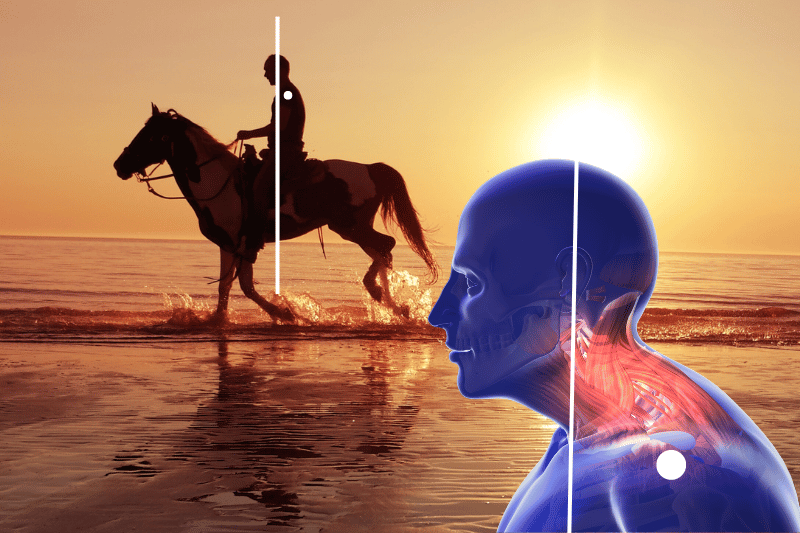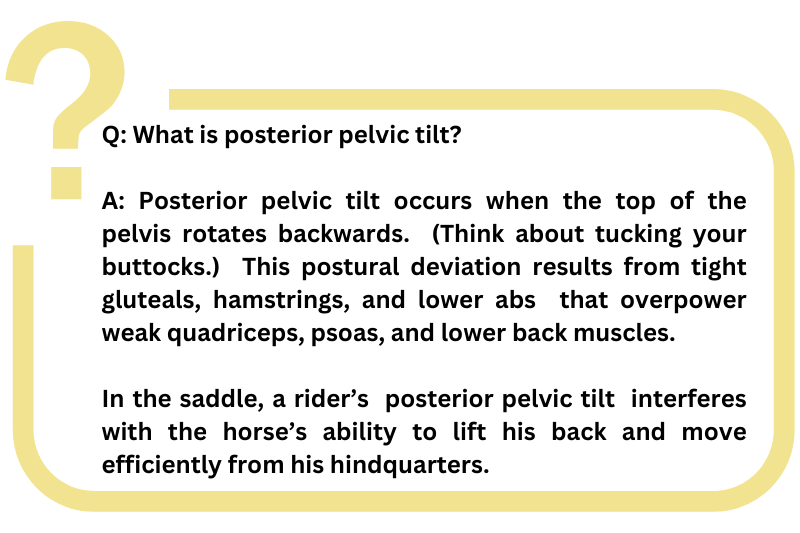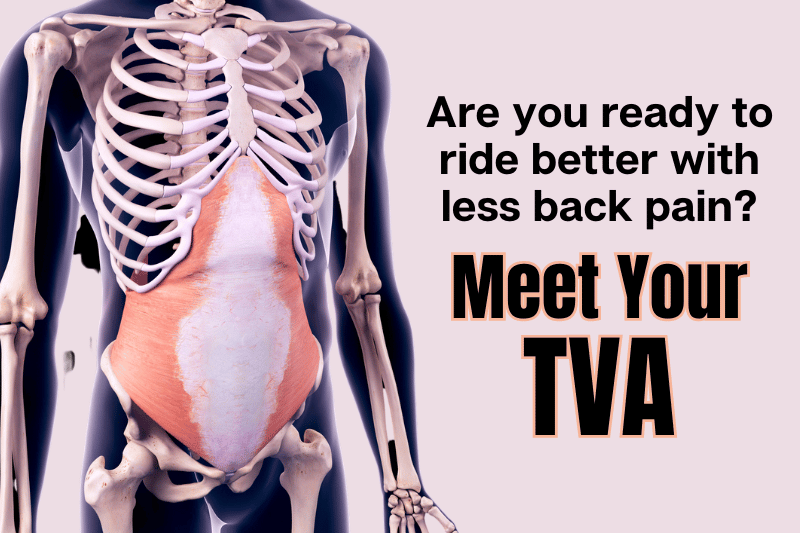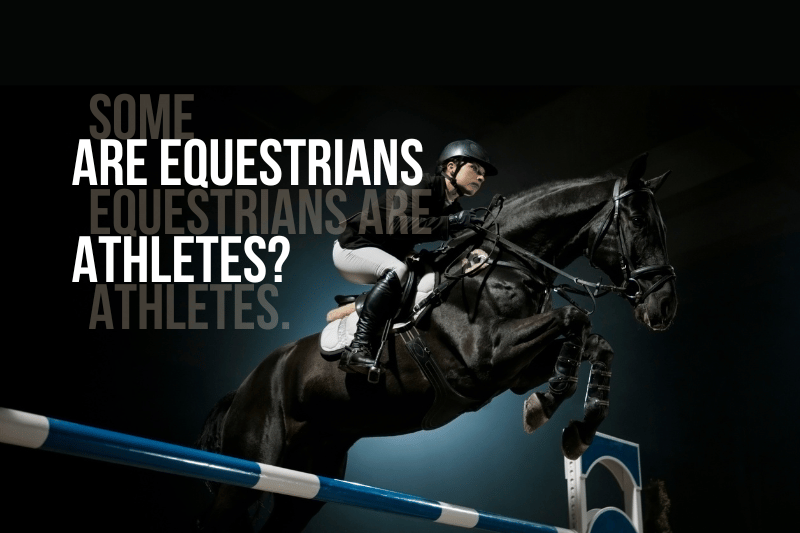Dozens of endurance ride photos march across my screen. Smiling riders wave back as I examine them, one by one. None of these riders are Sweaty Equestrian reader Jessie, but I’m scanning their photos because she asked:
“Do you have any suggestions for how I can improve my posture during endurance rides? I feel like I’m a secure and balanced rider, but I always look slouchy in my ride photos. It’s worse if I didn’t know my picture was being taken and sit up first. Help!”
I navigate to a different ride on the photographer’s website. More horses and riders trot across my screen. It’s clear that Jessie isn’t alone. In fact, many of the endurance riders in the photos exhibit one of the most common postural abnormalities in society today: Upper Crossed Syndrome (UCS).
You’ve probably heard of UCS’s little brother, Forward Head Posture, or FHP. It’s also known as tech neck, text neck, nerd neck, vulture neck, and other unflattering descriptors. FHP is that chronic jutting forward of the head that comes as an unfortunate side effect of a life spent staring down at laptops and phones.
FHP is often accompanied by slumped shoulders and a hunched back. Together, these are the hallmarks of UCS.
Regardless of age or gender, nearly all of us are at risk…and Jessie is right to be concerned. Aside from how we look in our ride photos, both FHP and UCS have negative impacts on endurance horses and riders alike.
Forward Head Posture & Upper Crossed Syndrome in Equestrians
Various studies on the subject indicate that about two-thirds of the United States’ population experiences FHP. Equestrians are no exception.
All too often, we bring our distorted office posture along to the saddle. The deviation transfers from our bodies to our horses’ bodies. Now, both partners are subject to additional strain and injury potential.
Throw in the overall weariness that comes with riding four, ten, sixteen hours or more, and we’re looking at a real pain in the neck!
Worse yet, FHP frequently evolves from a habit to a true muscle imbalance. In many people, it becomes just one symptom of the more complex postural deviation called Upper Crossed Syndrome.
Let’s take a closer look at the guy riding on the beach in this article’s cover photo. He looks a lot like Jessie and many other endurance riders.

Even in silhouette, we can see how the rider’s ear is ahead of his shoulder instead of aligned with it. His head juts forward, his shoulders slump, and his thoracic spine rounds.
He’s also sitting back on his tailbone, with his legs forward in a chair position. This is the result of the posterior pelvic tilt that often accompanies Upper Crossed Syndrome.
We could simply tell this rider to sit up straight and pull his shoulders back, like Jessie does when she sees the photographer ahead. However, there’s a good chance he’d do it improperly, by scrunching his shoulders toward his ears.
If he really does suffer from Upper Crossed Syndrome (and not just a bad photo like we all take sometimes), he’d unable to maintain an upright posture for long. As soon as his attention wandered, he’d be back to that forward-headed slump.
This is because Upper Crossed Syndrome is more than just a moment of postural laziness. Rather, it is the result of chronically overworking some muscle groups while overstretching others.
You’ve heard the term “muscle imbalance,” right? But what exactly does it mean?
Basically, the muscles attached to each side of a joint are supposed to have balanced levels of tension, holding the body in proper alignment.
Think about putting your hands at 10:00 and 2:00 on your car’s steering wheel, Driver’s Ed style. If you pull equally with both hands, the car goes straight. But what happens if one hand pulls even slightly harder than the other? Off the road we go!
Muscle imbalance works the same way: Short, tight, chronically overactive muscles on one side of a joint overwhelm the stretched, weak, underactive muscles on the other side. There goes our posture!
This 3-minute video does a good job of explaining how the weight of our forward-protruding heads leads to the muscle imbalances characteristic of UCS, which then contribute to degeneration of joints in the shoulder and spine.
Upper Crossed Syndrome actually features two sets of imbalanced muscles operating at the same time. Let’s zoom in on our rider on the beach:

Now you can see how Upper Crossed Syndrome gets its name.
We have weak cervical (deep neck) flexors in the front of the body and weak rhomboids and lower trapezius muscles in the back. These overstretched muscles form a criss-cross pattern with tight pectorals in the chest and tight upper traps in the upper back. (Technically, there are more muscles involved than shown here, but you get the gist.)
The smaller, inset image (courtesy of Active PhysioWorks) zooms out a bit to better reflect how far down the torso some of these muscles are located. It is about much more than the head!
As you can see, chronically stretched neck flexors and mid-back muscles elongate and weaken while chronically active chest and upper back muscles become short and tight. A jutting head and rounded shoulders become our default posture – not just in front of our screens, but also on the endurance trail.
How Does Upper Crossed Syndrome Affect the Endurance Rider?
Upper Crossed Syndrome (and FHP, to a lesser extent) impacts the human body in a variety of unpleasant ways, all of which become even less appealing in the context of distance riding.
For example:
- Compromised breathing
- Headaches
- Nerve pain or tingling, especially in the arms
- Fatigue
- Neck pain
- Shoulder pain
- Back pain
- Gastrointestinal symptoms, such as heartburn and GERD (1)
- Compromised proprioception and balance (2)
- Degeneration of shoulder and vertebral joints
- And (let’s be honest)… Less attractive ride photos
How Does Upper Crossed Syndrome Affect the Endurance Horse?
If you’re not sufficiently motivated to prevent or correct UCS or FHP for your own comfort, consider your horse.
Every inch that the rider’s head shifts forward from its ideal position (ear above shoulder) places about ten pounds of extra pressure on the cervical spine (Kapandji, Physiology of the Joints, Vol 3). The resulting spinal deviations typically cause the upper body to shift slightly forward while the curved upper back falls behind the vertical. Our spines are unable to flex properly with the horse’s movement. Commonly, posterior pelvic tilt and a forward leg follow.

All this results in the horse carrying more of the rider’s weight on his forehand. It also interferes with his ability to lift his back and drive from his hindquarters. The result is a high-headed, choppy stride with increased risk of stumbling and inefficient movement leading to early fatigue. Not an ideal scenario for endurance riding!
How Do I Know if I Have FHP or UCS?
There are several, easy ways to determine whether you have Forward Head Posture or even Upper Crossed Syndrome.
Look at your riding photos, and have someone take a few photos of you standing and sitting naturally (sans horse).
Do you frequently have the postural deviations described above? Look for:
- Ear positioned ahead of your shoulder joint
- Curve or hump at the base of your neck
- Slumped shoulders
- Thoracic spine kyphosis (slouchy mid-back)
You can also try getting some video of yourself in motion. If you perform a cable row in the gym or pull back on the reins as if to stop a runaway horse, do you see your head move forward and your shoulders rise toward your ears?
If your neck chronically slants forward and your head juts ahead of your shoulders, you probably have FHP. Add rounded shoulders and a hunched upper back, and you may be looking at UCS.
Some feel no discomfort, but if you have FHP/UCS, you may also have been experiencing strain at the back of your neck, upper back pain, chest tightness, headaches, nerve pain or tingling in your arms, or even acid reflux.
If you think you do, indeed, have FHP or full-on UCS, don’t despair! Most of us experience this to some degree.
The good news is that we can usually fix it. The sooner we start, the better off we — and our horses — will be.
How to Correct FHP / UCS and Improve Your Riding
Let me begin by emphasizing that I am not a medical professional. This information is intended to give you a general idea of how many individuals can address the muscle imbalances associated with Forward Head Posture and Upper Crossed Syndrome. The exercises are not customized for your particular body.
It’s always wise to check with your doctor before trying new exercises, particularly if you think you have a severe case or are experiencing disturbing symptoms like migraines, nerve pain, or GERD.
That said, muscle imbalances (including FHP/UCS) are typically addressed by stretching the overactive muscles and strengthening the underactive ones.
This video from GuerrillaZen Fitness does a nice job of showing one exercise to address each of the four affected areas in cases of UCS (pectorals, lower traps, cervical flexors, and lower traps):
Here’s another video from a doctor focused on exercises to correct Forward Head Posture:
As you can see, correcting or preventing FHP / UCS is a bit of a commitment. To fit it in, I make a point of:
- Using the Stand Up app to remind me to correct my posture frequently during desk work.
- Doing the neck flexor strengthening exercise that starts at 3:34 in the second video above throughout the day. (I pair this with cutting down on social media use by doing the exercise every time I’m tempted to look at Facebook.)
- Incorporating one stretching and one strengthening exercise targeting UCS described into each of my workouts.
Most of us struggle to commit all the time our bodies deserve, but a little effort goes a long way. Will you try it?




